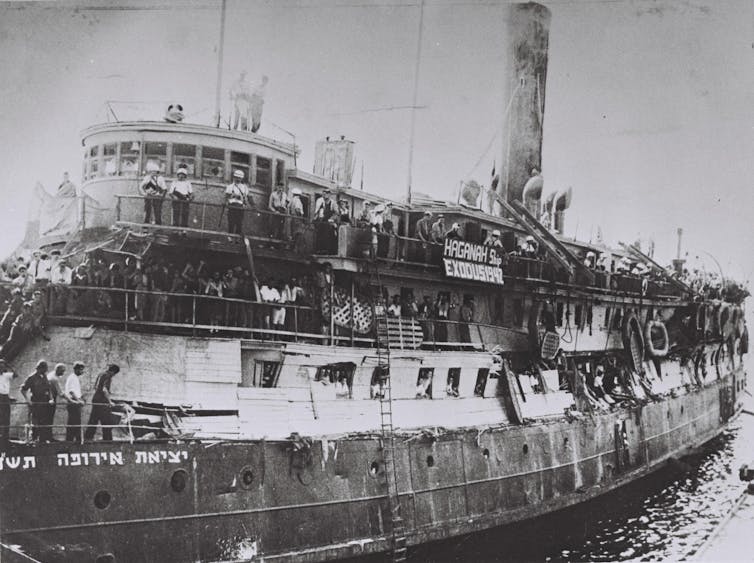The Aquarius, a rescue ship in the Mediterranean carrying 629 people, is now on its way to Spain, after being refused docking in Italy and Malta. The crisis has caused a diplomatic row between France and Italy and highlighted the stalemate within the EU on asylum policy.
Sadly, there have been many historical examples of boats laden with refugees, that were refused docking.
In the aftermath of World War II, the historian Eugene Kulischer wrote: “The refugee is the first peaceful immigrant”. Yet since then, refugees fleeing dictatorships, war and revolution have become the post-war order’s persistently inconvenient immigrant. The detention system that continues to hold them in limbo has expanded in response, as has the language that marks their exclusion: the “uprooted”, the “unwanted”, “the illegals”, and the “boat people”.
These terms, and the UN Refugee Convention of 1951 that was intended to protect them, induced a quandary about responsibility: to whom do refugees “belong”? This question recalls a global history of obstruction by governments of all persuasions that were particularly acute during the 1930s and 1940s in Europe and, in the 1970s, in South-East Asia.
The St Louis
The wandering refugee boat is often associated with just over 900 persecuted German-Jewish refugees aboard the St Louis from May 13 to June 17, 1939. The postures of international diplomats and government representations at the Evian Conference in France in July 1938 had failed them, and the refugees’ visas for Cuba were refused.
The captain then steered the ship to Miami and Halifax, Canada, before the bulk of its passengers were distributed between Britain, France, Belgium and the Netherlands. Reported by the media of the time, the St. Louis was an early and not unique precedent of obstruction due to local prejudice and anti-immigration policies.
The Pentcho
More unusual was the multi-year odyssey of 500 German and Czech Jewish refugees that began on the Bulgarian ship, the Pentcho, in May 1940. Organised by the right-wing Revisionist Zionist movement to bring 500 Jews to Palestine, the Pentcho’s route from Bratislava via the Danube and to the Greek island of Lesbos was aborted when its refuelling was refused. The ship foundered in the Dodecanese islands and the refugees were permitted to disembark at Kamilonissi.
On October 18 and 19, 1940, Italian authorities brought the refugees to Rhodes and from there to Ferramonti internment camp in Southern Italy in January 1942. They were interned with other “undesirables” and “enemy aliens” until they were liberated by the British Army in September 1943. In May 1944, 254 internees left Ferramonti for Palestine on the first emigration transport organised by British authorities, while others were resettled in the United States.
The Exodus
Transnational journeys continued for Holocaust survivors languishing in displaced persons’ camps created in allied zones of occupied Germany, Austria and Italy after World War II. Ports in France, Bulgaria and Italy were departure points for the Aliyah Bet, the Hebrew term given to the Zionist clandestine immigration operation that was run by the Hagana (the military unit of the Jewish community in Palestine) to transport 70,000 Holocaust survivors to the British-controlled territory up to 1948. From August 1946, British authorities intercepted these boats, as they were in violation of a 1939 White Paper which restricted Jewish immigration. Refugees were thereafter sent to detention camps in Cyprus.
Detention also awaited close to 5,000 passengers aboard the overcrowded Exodus, which sailed from France in July 1947. On July 18, 20 miles off the coast of Gaza, the British Navy attempted to intercept the ship. Fatalities ensued and most of the refugees were returned to camps in Europe. The event was reported around the world and turned public opinion against the British. It provided a catalyst to the UN Partition of Palestine in November 1947, Israel’s statehood in May 1948 – and to decades of displacement and violence.

The Hai Hong
Refugee flight continued throughout the decolonisation of South-East Asia and as a consequence of the Vietnam War. Particularly notable was the flight of at least one million Vietnamese refugees from the mid-1970s to Australia, the US, and other Asian countries.
But obstruction met the 2,500 Vietnamese passengers aboard the Hai Hong, which sailed into Port Klang, in Malaysia, on November 9, 1978. Most of the passengers were ethnic Chinese who were refused disembarkation due to suspicions that they had “bought their way out” of Vietnam and were not “true refugees”. They remained at port in Malaysia until the US and countries in Western Europe accepted them.
Attempts to address the Vietnamese “boat people” crisis included a UN Conference on Indochinese Refugees, in July 1979. The then US vice president, Walter Mondale, recalled the Evian Conference of 1938 when he exhorted attendees not to tolerate refugees’ continued expulsion across Indochina, and to fashion “a world solution”. Four decades on, that still hasn’t happened.
Governments across southern Europe are currently rushing to congratulate themselves on refusing refugee boats from North Africa and the Middle East. The only certainty we have, as these historical examples illustrate, is more of the same: watching refugee boats cross the Mediterranean Sea with little reprieve of their misery.

